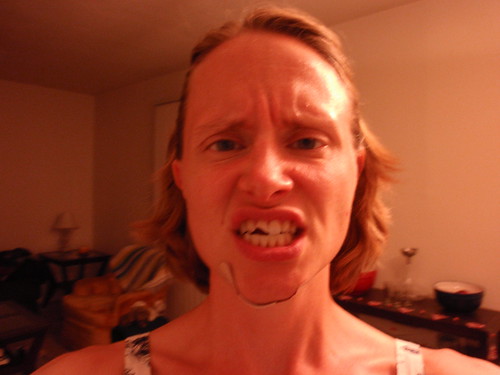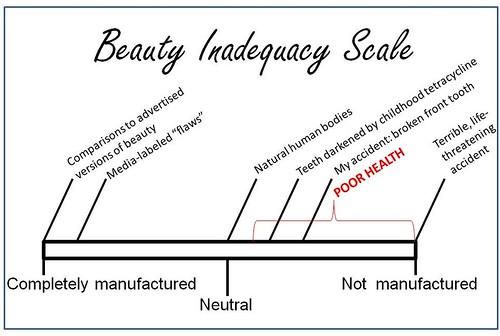This post is Part 2 of a series. You can find Part 1 here.
I think inadequacy is the greatest myth our culture has forced upon us.
The more I see American culture through this lens, the more convinced I am that we are marinating in a bath of manufactured inadequacy. Consumer culture, it seems, needs us to feel inadequate so it can sell us stuff to cure our inadequacy. Except nothing we buy can accomplish that goal. In the battle against feeling broken, we cannot win.
Until we start believing that we are not broken. We are just human.
As I mentioned in Part 1, Self magazine reentered my life just a day before I fell and broke my front tooth and split my chin open. I was not such a pretty picture.
Granted, this photo was taken at night, so the lighting is not terrific. But I maintain that having a jagged half-tooth is pretty scary-looking. In addition, losing that tooth gave me a temporary lisp which was bad enough that when I left my phone number on the dentist’s voicemail, I worried he wouldn’t be able to call me back because what number is theven? thero? thikth?? I’m exaggerating a bit here, but the lisp was really frustrating. And there wasn’t really much I could do about it without a dentist.
Flipping through Self that weekend, I was struck by the way the rhetoric of the magazine took normal human needs, activities, and body parts and turned them into problems. Your appetite is a problem. Better eat high-protein/low-carb to tame that appetite! Ugh, you know what else is a problem? Your ass. Better do this work-out before it gets any bigger. Also a problem: your desire to be in a romantic relationship. Better be hard to get or else the menfolk will think you’re desperate.
Now, I realize that to some extent, much of the content of Self could be filed under self-improvement. But how much of the “need” for self-improvement is actually being manufactured by magazines like Self, with their endless barrage of flat abs and tall models? In my mind, this question stood in stark contrast to my own situation, where my lovely, imperfect smile had become a trainwreck. I could no longer eat or speak normally. I could get through a few days like that because I had faith that a dentist could fix me, but what if I’d been stuck with my broken tooth for six months? I’m sure that over time, I would have become more self-conscious in front of others, sticking to close-lipped smiles to avoid that awkward feeling. I didn’t mind being with Paul while I felt ugly because he didn’t seem to mind. But I did enjoy growling at him with my teeth bared, just because I thought it was funny.
When you’re missing your front tooth, other beauty inadequacies seem so much more contrived. When you lose something valuable, you are reminded of your assets. A few days after I got my new tooth, another issue of Self arrived, this one with an article about (of all things!) cosmetic dentistry. Let me just say upfront that I am so glad this article arrived after my dentist appointment, as it was a series of horror stories about how things can go terribly wrong in cosmetic dentistry. My experience with Dr. Kaiser’s office was wonderful—I could not have asked for better care. In my case, the dental work didn’t feel optional, though I suppose that strictly speaking, it was. Even getting a crown was optional: at first, they were going to give me a “smiler only” tooth which would not allow me to eat crunchy vegetables and fruits. That wasn’t good enough for me; I wasn’t willing to sacrifice my eating habits to save money. So I got an expensive crown, and now I can eat raw carrots again. In the Self article, the women interviewed had experienced different dental issues. One had yellowish gray teeth from a childhood tetracycline treatment. Another woman, like me, had an accident and damaged her front teeth. Both women sought help for their imperfect teeth, and both had awful results from cosmetic dentistry. The upside is that eventually, after lots of botched results and money spent, both women are happy with their smiles.
Happy with their smiles. Is that too much to ask?
Thinking about their stories, I decided to make a plot for the Beauty Inadequacy Scale in which the axis goes from completely manufactured “inadequacy” (like the idea that abs should be perfectly flat or that teeth should be perfectly white) to not manufactured, such as the damage after a bad accident. I put my own accident on this axis, too. This image puts things into perspective for me.
It’s not complete by any means. The point is to remind us that many of our feelings of inadequacy are manufactured for us by others, particularly advertising and media. I know that’s not a groundbreaking revelation. But being on the other side of beauty, feeling ugly, even just for a few days, reminded me of how much I take my everyday appearance for granted. How much I take my teeth for granted. There’s a strong temptation for us to compare ourselves to others or unrealistic images in the media and to think, I want to look like that! But when we lose something, we forget about those comparisons. We think, I want my teeth back. Or I want to be able to walk again. Those losses serve as powerful reminders of how wonderful it is to have a healthy, fully functioning body. They remind us that we were never inadequate, just human. Flawed and beautiful and perfectly adequate, just as we are.




No comments:
Post a Comment